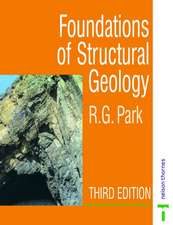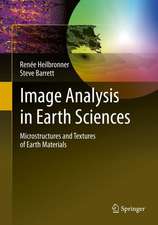Physics and Chemistry of Partially Molten Rocks: Petrology and Structural Geology, cartea 11
Editat de N. Bagdassarov, D. Laporte, Alan Bruce Thompsonen Limba Engleză Hardback – 31 dec 1999
This special volume contains contributions presented at the symposium `Physics and Chemistry of Partially Molten Systems' of the EUG 9 meeting, held in Strasbourg, France, on March 23-27, 1997. It is intended to provide a current understanding of the physics of partial melting and melt segregation and covers topics such as the rheology of partially molten systems, the topology of partial melts, modelling of partial melting processes, and field observations of partial melts.
Audience: This book is intended for a broad readership, including graduate students, specializing in petrology and geodynamics. The volume may be recommended as a textbook for graduate courses on petrology, geomaterial sciences and geophysics.
| Toate formatele și edițiile | Preț | Express |
|---|---|---|
| Paperback (1) | 640.24 lei 6-8 săpt. | |
| SPRINGER NETHERLANDS – 27 sep 2012 | 640.24 lei 6-8 săpt. | |
| Hardback (1) | 646.43 lei 6-8 săpt. | |
| SPRINGER NETHERLANDS – 31 dec 1999 | 646.43 lei 6-8 săpt. |
Preț: 646.43 lei
Preț vechi: 760.50 lei
-15% Nou
Puncte Express: 970
Preț estimativ în valută:
123.69€ • 129.84$ • 102.67£
123.69€ • 129.84$ • 102.67£
Carte tipărită la comandă
Livrare economică 10-24 aprilie
Preluare comenzi: 021 569.72.76
Specificații
ISBN-13: 9780412847202
ISBN-10: 0412847205
Pagini: 271
Ilustrații: XVI, 271 p.
Dimensiuni: 155 x 235 x 18 mm
Greutate: 0.59 kg
Ediția:2000
Editura: SPRINGER NETHERLANDS
Colecția Springer
Seria Petrology and Structural Geology
Locul publicării:Dordrecht, Netherlands
ISBN-10: 0412847205
Pagini: 271
Ilustrații: XVI, 271 p.
Dimensiuni: 155 x 235 x 18 mm
Greutate: 0.59 kg
Ediția:2000
Editura: SPRINGER NETHERLANDS
Colecția Springer
Seria Petrology and Structural Geology
Locul publicării:Dordrecht, Netherlands
Public țintă
ResearchCuprins
1. Rheology of Partially Molten Rocks.- 1. Introduction.- 2. Constitutive equations.- 3. Discussion.- 2. Anelastic and Viscoelastic Behaviour of Partially Molten Rocks and Lavas.- 1. Introduction.- 2. Experimental methods of Q measurement.- 3. Experiments.- 4. Discussion.- 5. Conclusions.- 3. Constraints on the Melt Distribution in Anisotropic Polycrystalline Aggregates Undergoing Grain Growth.- 1. Introduction.- 2. Surface energy considerations.- 3. Experimental observations: the system olivine + basaltic melt.- 4. Summary and implications for partial melts in the mantle.- 4. The Grain-scale Distribution of Silicate, Carbonate and Metallosulfide Partial Melts: a Review of Theory and Experiments.- 1. Introduction.- 2. Interfacial energies.- 3. Textural equilibrium.- 4. Equilibrium melt distribution in an idealized partially molten system.- 5. Wetting properties of geological partial melts.- 6. Discussion.- 5. Partial Melting and Melt Segregation in a Convecting Mantle.- 1. Introduction.- 2. General aspects of melting in the mantle.- 3. The physics of melt generation, segregation and convection.- 4. Case studies relevant for melting and segregation in a convecting mantle.- 5. Conclusions.- 6. A Fractionation Model for Hydrous Calc-Alkaline Plutons and the Heat Budget During Fractional Crystallisation and Assimilation.- 1. Introduction.- 2. Fractional crystallisation of hydrous mantle magma.- 3. Crystallisation(C), fractional crystallisation (FC) and assimilation (A) hydrous mantle magmas.- 4. Comparison of the heat balance for AFC processes with other results for crustal melting.- 5. Conclusions.- 7. Migmaticic Gabbros From a Shallow-Level Metamorphic Contact Aureole, Fuerteventura Basal Complex, Canary Islands: Role of Deformation in Melt Segregation.- 1. Introduction.-2. Tectonic and geological setting.- 3. The PX1 intrusion and its host rock.- 4. Partial melting and mechanisms of melt segregation.- 5. Rheology of partly molten rocks.- 6. Discussion.- 7. Conclusion.- 8. Thin Amorphous Intergranular Layers at Mineral Interfaces in Xenoliths: the Early Stage of Melting.- 1. Introduction.- 2. Sample preparation and analytical methods.- 3. Sample description.- 4. Definitions.- 5. Results.- 6. Discussion.



















